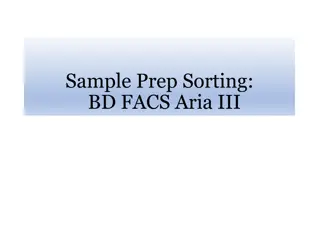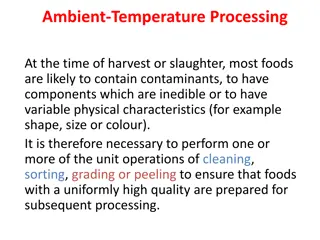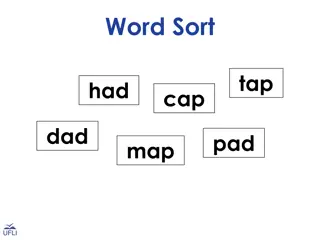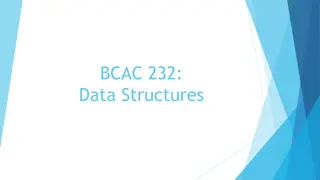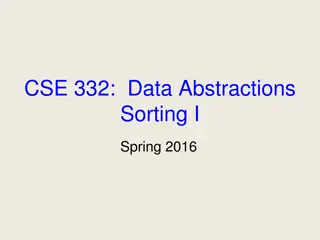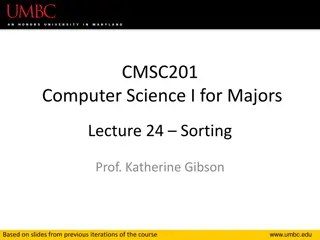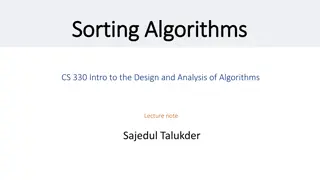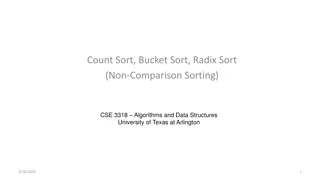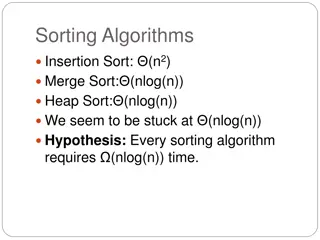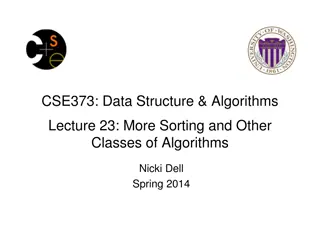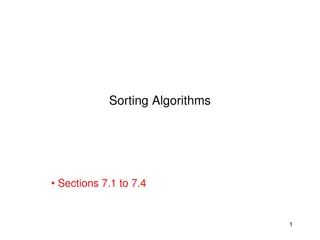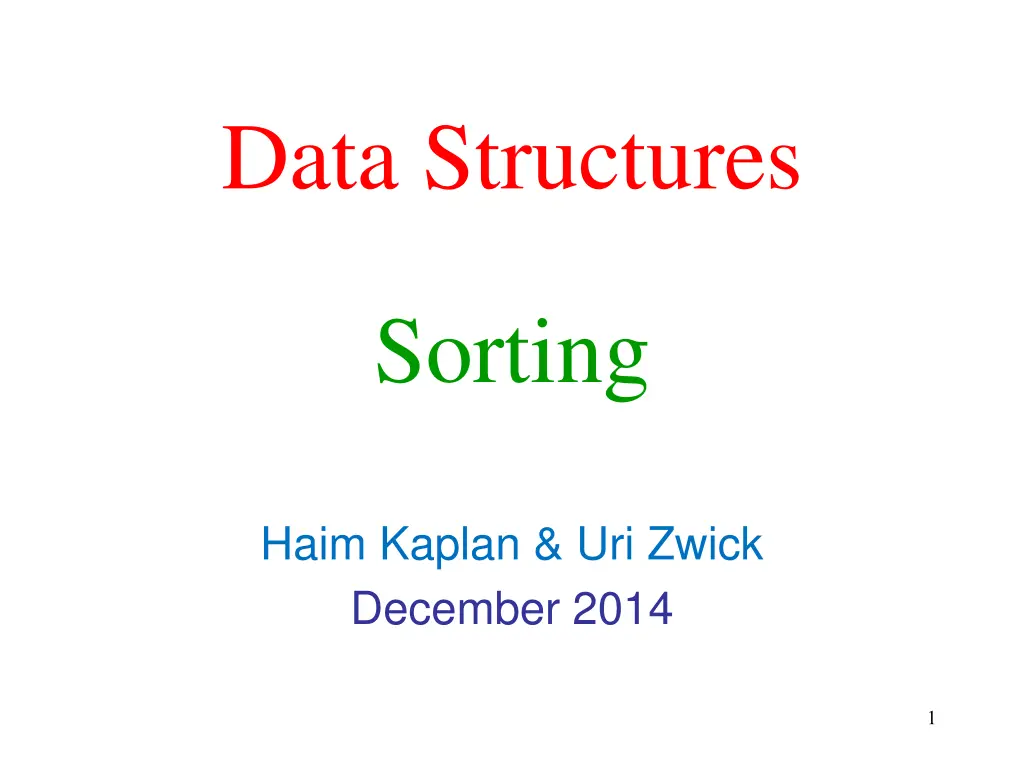
Efficient Sorting Algorithms Overview
"Explore comparison-based sorting methods like Insertion Sort, Bubble Sort, and Quicksort. Learn about their performance, optimizations, and key principles for in-place sorting. Discover the best strategies for small and large input sizes."
Download Presentation

Please find below an Image/Link to download the presentation.
The content on the website is provided AS IS for your information and personal use only. It may not be sold, licensed, or shared on other websites without obtaining consent from the author. If you encounter any issues during the download, it is possible that the publisher has removed the file from their server.
You are allowed to download the files provided on this website for personal or commercial use, subject to the condition that they are used lawfully. All files are the property of their respective owners.
The content on the website is provided AS IS for your information and personal use only. It may not be sold, licensed, or shared on other websites without obtaining consent from the author.
E N D
Presentation Transcript
Data Structures Sorting Haim Kaplan & Uri Zwick December 2014 1
Comparison based sorting key a1 a2 an info Input:An array containing n items Keys belong to a totally ordered domain Two keys can be compared in O(1) time Output: The array with the items reordered so that a1 a2 an in-place sorting info may contain initial position
Comparison based sorting Insertion sort Bubble sort O(n2) Balanced search trees Heapsort Merge sort O(nlogn) O(nlogn) expected time Quicksort
Warm-up: Insertion sort Worst case O(n2) Best case O(n) Efficient for small values of n
Warm-up: Insertion sort Slightly optimized. Worst case still O(n2) Even more efficient for small values of n
Warm-up: Insertion sort (Adapted from Bentley s Programming Peals, Second Edition, p. 116.)
AlgoRythmics Insertion sort Bubble sort Select sort Shell sort Merge sort Quicksort 7
Quicksort [Hoare (1961)] 8
Quicksort < A[p] A[p] 9
partition If A[j] A[r] < A[r] A[r] < A[r] A[r] 10
partition If A[j] < A[r] < A[r] A[r] < A[r] A[r] 11
r p Lomuto s partition < A[r] A[r] 12
partition Use last key as pivot (Is it a good choice?) 2 8 7 1 3 5 6 4 2 8 7 1 3 5 6 4 2 8 7 1 3 5 6 4 i last key < A[r] j next key to inspect 2 8 7 1 3 5 6 4 2 1 7 8 3 5 6 4 13
j i 2 1 7 8 3 5 6 4 i j 2 1 3 8 7 5 6 4 j i 2 1 3 8 7 5 6 4 i j 2 1 3 8 7 5 6 4 Move pivot into position j i 2 1 3 4 7 5 6 8 14
Hoares partition A[r] A[r] Performs less swaps than Lomuto s partition Produces a more balanced partition when keys contain repetitions. Used in practice 15
Hoares partition A[i] < A[r] A[r] A[r] A[r] A[r] 16
Hoares partition A[j] > A[r] A[r] A[r] A[r] A[r] 17
Hoares partition A[i] A[r] , A[j] A[r] A[r] A[r] A[r] A[r] 18
Analysis of quicksort Best case: n (n 1)/2 , 1 , (n 1)/2 Worst case: n n 1 , 1 , 0 Average case: n i 1 , 1 , n i where i is chosen randomly from {1,2, ,n} Worst case obtained when array is sorted Average case obtained when array is in random order Let Cnbe the number of comparisons performed 19
Best case of quicksort By easy induction 20
Worst case of quicksort By easy induction 23
Worst case of quicksort Worst case is really bad Obtained when array is sorted 24
How do we avoid the worst case? Use a random item as pivot Running time is now a random variable Average case now obtained for any input For any input, bad behavior is extremely unlikely For simplicity, we consider the expected running time, or more precisely, expected number of comparisons 25
Randomized quicksort (How do we generate random numbers?) 26
Analysis of (rand-)quicksort using recurrence relations (Actually, not that complicated) P2C2E 27
Analysis of (rand-)quicksort Let the input keys be z1< z2< < zn Proof by induction on the size of the array Basis: If n=2, then i=1 and j=2, and the probability that z1and z2are compared is indeed 1 29
Analysis of (rand-)quicksort Induction step: Suppose result holds for all arrays of size < n Let zkbe the chosen pivot key The probability that ziand zjare compared, given that zkis the pivot element 30
Analysis of (rand-)quicksort Let zkbe the chosen pivot key If k<i, both ziand zjwill be in the right sub-array, without being compared during the partition. In the right sub-array they are now z i kand z j k. If k>j, both ziand zjwill be in the left sub-array, without being compared during the partition. In the left sub-array they are now z iand z j. If k=i or k=j, then ziand zjare compared If i<k<j, then ziand zjare not compared 31
Analysis of (rand-)quicksort (by induction) (by induction) 32
Analysis of (rand-)quicksort Exact version 34
Lower bound for comparison-based sorting algorithms 35
The comparison model Items to be sorted a1, a2, , an i : j < Sorting algorithm The only access that the algorithm has to the input is via comparisons 36
comparison-based sorting algorithm comparison tree
Insertion sort x y z x:y > < x y z y x z x:z y:z < > > y z x y:z x:z x z y y x z x y z > > < < z y x x z y y z x z x y
Quicksort x y z x:z > < y:z y:z < > < > x:y x y z y z x z x y x z y x:y > < > < x y z y x z z y x z x y
Comparison trees Every comparison-based sorting algorithm can be converted into a comparison tree. Comparison trees are binary trees The comparison tree of a (correct) sorting algorithm has n! leaves. (Note: the size of a comparison tree is huge. We are only using comparison trees in proofs.) 40
Comparison trees A run of the sorting algorithm corresponds to a root-leaf path in the comparison tree Maximum number of comparisons is therefore the height of the tree Average number of comparisons, over all input orders, is the average depth of leaves 41
Depth and average depth Height = 3 (maximal depth of leaf) 1 2 Average depth of leaves = (1+2+3+3)/4 = 9/4 3 3 42
Maximum and average depth of trees Lemma 2, of course, implies Lemma 1 Lemma 1 is obvious: a tree of depth k contains at most 2kleaves 43
Average depth of trees Proof by induction (by induction) (by convexity of x log x) 44
Convexity 45
Lower bounds Theorem 1: Any comparison-based sorting algorithm must perform at least log2(n!) comparisons on some input. Theorem 2: The average number of comparisons, over all input orders, performed by any comparison- based sorting algorithm is at least log2(n!). 46
Approximating sums by integrals f increasing 48
Randomized algorithms The lower bounds we proved so far apply only to deterministic algorithms Maybe there is a randomized comparison-based algorithm that performs an expected number of o(n logn) comparisons on any input? 49
Randomized algorithms A randomized algorithm R may be viewed as a probability distribution over deterministic algorithms R: Run Diwith probability pi, for 1 i N (Perform all the random choices in advance) 50

